Tremoctopodidae
Tremoctopus
Blanket octopus
Katharina M. Mangold (1922-2003), Michael Vecchione, and Richard E. YoungThe Tremoctopodidae contains a single genus with the following four species:
- Tremoctopus violaceus
- Tremoctopus gelatus
- Tremoctopus gracilis
- Tremoctopus robsoni
Introduction
Most species have large, muscular females, ca. 1 m or more in total length, that occupy surface waters of tropical and subtropical oceans. In females the dorsal and dorsolateral arms are distinctly longer than arms III and IV and are connected by an extensive web which is absent from the other arms.

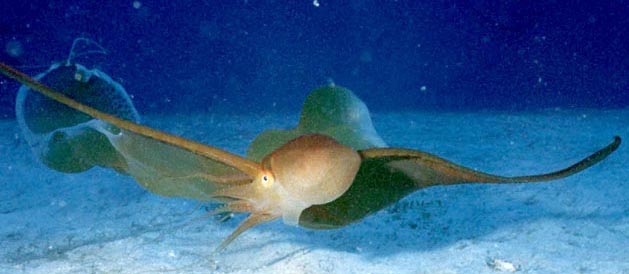
Figure. T. violaceus swimming just above the shallow ocean floor. Note the string-like structure trailing from the broad web of arm I. This "string" is actually the slender arm I extending beyond the web. Posterolateral view of T. violaceus swimming just above the shallow ocean floor. Photographed by Rob Rush at 68 feet deep off Delray Beach Ledge, Florida, USA (near 26°N 80°W), May 12, 2001, 9:06 AM local time.
Large ocelli can be displayed on the dorsal web. This web and the slender tip of the arms can, apparently, be autotomized along visible "fracture" lines. The autotomized arms and membranes presumably wiggle to distract or cling to a predator while the octopod swims away. Evidence for this and additional photographs of free-swimming T. violaceus can be seen here. Apparently the web is only extended when the octopod is threatened. A video on YouTube shows the large web rolled up and held close to the mouth. The blanket octopod seen in this video was filmed in the Sea of Japan (T. Kubodera, pers. comm.)

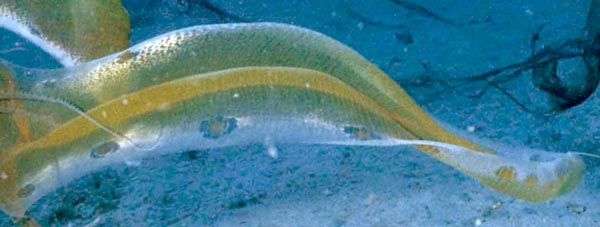
Figure. Same individual of T. violaceus pictured above, showing web and ocelli on arm I. Photographed by Rob Rush.
The color phase most typically associated with T. violaceus is with silvery sides and a very dark purple/blue dorsal surface.

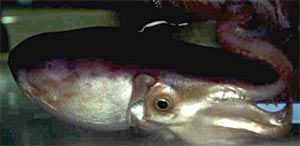
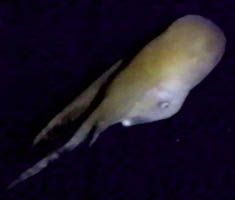
Figure. The picture of T. violaceus on the left, taken in an aquarium, shows the typical color pattern. Photograph taken by Vicente Hernandez. The photograph on the right of Tremoctopus sp. taken from a submersible shows the octopod swimming at a depth of 340 m and about 5 m above the bottom in Hawaiian waters. An AVI format video clip of this individual is available at Cephalopods in Action. Submersible photograph courtesy of the Hawaii Undersea Research Laboratory.
Brief diagnosis:
An argonautoid ...
- with extensive web between dorsal four arms; web virtually absent between other arms (females).
Characteristics
- Arms
- Dorsal four arms (arms I and II) much longer than ventral four arms (arms III and IV).
- Deep web present between dorsal four arms (see title photograph).
- Hectocotylus develops in sac burried beneath right eye.
- Proximal half of hectocotylus with papillate lateral fringes.
 Click on an image to view larger version & data in a new window
Click on an image to view larger version & data in a new window
Figure. Hectocotylus of Tremoctopus violaceus.Top - Oral view of the hectocotylus still attached to the male. Bottom - Median section through the distal end of the hectocotylus with an empty spermatophore receptacle. Drawings from Naef, 1921-3.
- Eggs attached to rod-like structure carried in arms of females
- Head
- Beaks: Descriptions can be found here: Lower beak; upper beak.
- Radula: First lateral teeth of radula much smaller than rachidian or second lateral teeth.
- Beaks: Descriptions can be found here: Lower beak; upper beak.
- Sexual dimorphism
- Males dwarf.
- Males dwarf.
- Swim bladder
- Hydrostatic organ (swim bladder) present dorsal to digestive system.
- Hydrostatic organ (swim bladder) present dorsal to digestive system.
- Water pores
- Present at base of dorsal and ventral arms.
 Click on an image to view larger version & data in a new window
Click on an image to view larger version & data in a new window
Figure. Two views of a swimming T. violaceus showing water pores (arrows). Left - View of the dorsal water pores. Right - View of the ventral water pores. Photographs by Peter Wirtz.
- Present at base of dorsal and ventral arms.
Comments
The presence of a hydrostatic organ was recently reported by Bizikov (2004).Nomenclature
A list of all nominal genera and species in the Tremoctopodidae can be found here. The list includes the current status and type species of all genera, and the current status, type repository and type locality of all species and all pertinent references.
The systematics of the Tremoctopodidae was review by Thomas (1977). He concluded that two species existed, T. violaceus and his new species T. gelatus Thomas, 1977. The former species he divided into two subspecies, T. v. violaceus, from the Atlantic Ocean and T. v. gracilis, from the Pacific and Indian Oceans. O'Shea (1999) has resurrected a New Zealand species, T. robsoni. Since the degree of difference between the latter and T. violaceus is of the same order as that between the two subspecies of T. violaceus we here elevate the two subspecies to specific level:
- Tremoctopus violaceus violaceus Chiaie, 1830 becomes Tremoctopus violaceus Chiaie, 1830
- Tremoctopus violaceus gracilis (Eydoux and Souleyet, 1852). becomes Tremoctopus gracilis (Eydoux and Souleyet, 1852).
There is some confusion on the proper name of T. robsoni. Mike Sweeney (USNMNH) explains: "The name Tremoctopus robsonianus is in the title of the paper (an abstract from a meeting of the Wellington Philosophical Society). However the taxon is introduced in the text with the name Tremoctopus robsoni n.sp. The taxon was published in the 1883 volume (#16) of the Transactions of the New Zealand Institute, but had a publication date of May 1884." The correct name is Tremoctopus robsoni Kirk, 1884.
Species
Of the four recognized species, T. gelatus is easily recognized by its gelatinous consistency and generally pale pigmentation, the other three species are very similar. The most useful character is the number of sucker pairs on the distal half of the hectocotylus of the male. Another character is the number of gill filaments on the outer demibranch of the gill not including the terminal filament.
| Species | Consistency | Distal hecto. suckers | Gill filaments males | Gill filaments females |
| T. violaceus | Muscular | 15-19 pairs | 9-11 | 13-16 |
| T. gracilis | Muscular | 19-22 pairs | 9-11 | 13-16 |
| T. robsoni | Muscular | 27-28 pairs | 10-13 | 15 |
| T. gelatus | Gelatinous | - ? - | 7-8 | 8-11 |
Figure. Left - ventral and dorsal views of T. gelatus, 328 mm ML, from Thomas, 1977. Drawing printed with the Permission of the Bulletin of Marine Science. Right - Dorsal view of T. robsoni, 61 mm ML. Drawing from O'Shea, 1999.
A few additional features on the hectocotylus seem to have specific value. The proximal suckers number 22-23 pairs in T. violaceus, 27-29 pairs in T. gracilis (Thomas, 1977) and 9-15 in T. robsoni according to the figures shown here from O'Shea, 1999. Also the hectocotylus of the first two species has a fringe of fleshy papillae that extend the full length of the proximal section, while the third species, according to the illustration, has the fringe restricted to the base of the proximal section.
Figure. Oral views of three hectocotyli of T. robsoni. Drawings from O'Shea, 1999.
Behavior
Young individuals carry broken tentacles of cnidarians, frequently the Portuguese man-of-war (jellyfish), using the suckers of the dorsal four arms. The borrowed tentacles, which have stinging cells, presumably have a defensive and/or offensive function.


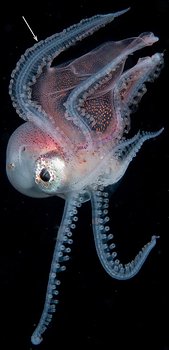
Young Tremoctopus gracilis, 10-15 mm ML (guess). Arrows point to jellyfish tentacles held by the four dorsal arm suckers; compare this with the appearance of the four ventral-arm suckers that carry no tentacles. Left - Side view, female (?), Photographed in situ while scuba diving at night, off the Kona Coast of Hawaii Isl. © 2015 Jeffrey Milisen. Right - Oblique front view. Note how widely the sucker rows of the dorsal arms are separated due to the long, slender stalks of each sucker. Note also that this juvenile is exhaling both through the funnel and the upper mantle opening. Photographed in situ while scuba diving at night in Janao Bay, Phillippines. © 2018 Mike Bartick
Life History
Males are dwarfs (15 mm ML), often reaching only 5-10% of the female size. The females carry numerous (100,000 to 150,000) small eggs (0.9 X 1.5 mm in size). The eggs are attached to a secreted sausage-shaped rod held at the base of the dorsal arms and carried by the female until hatching. The hatchling has the arm bases in a cuff as in Argonauta. Data are from Thomas (1977) and Naef (1921/23). More information of the brooding female, the egg mass, embryos and hatchlings can be found here.
Distribution
T. violaceus lives in the Atlantic and T. gracilis in the Indo-Pacific; T. gelatus is a deep-living, gelatinous, presumably mesopelagic, species that is cosmopolitan in tropical and temperate seas (Thomas, 1977). T. robsoni is known from waters off New Zealand (O'Shea, 1999).
References
Bizikov, V. A. 2004. The shell in Vampyropoda (Cephalopoda): Morphology, functional role and evolution. Ruthenica. Supplement 3: 1-88.
Naef, A. 1921-23. Cephalopoda. Fauna und Flora des Golfes von Neapel. Monograph, no. 35. English translation: A. Mercado (1972). Israel Program for Scientific Translations Ltd., Jerusalem, Israel. 863pp., IPST Cat. No. 5110/1,2.
O'Shea, Steve. 1999. The Marine Fauna of New Zealand: Octopoda (Mollusca: Cephalopoda). NIWA Biodiversity Memoir 112:280pp.
Thomas, R. F. 1977. Systematics, distribution, and biology of cephalopods of the genus Tremoctopus (Octopoda:Tremoctopodidae). Bull. Mar. Sci. 27: 353-392.
Information on the Internet
- Tremoctopus defense mechanism. YouTube.
About This Page
Illustrations from Thomas (1977) printed with the Permission of the Bulletin of Marine Science.
Katharina M. Mangold (1922-2003)

Laboratoire Arago, Banyuls-Sur-Mer, France

National Museum of Natural History, Washington, D. C. , USA

University of Hawaii, Honolulu, HI, USA
Page copyright © 2018 Katharina M. Mangold (1922-2003), , and
 Page: Tree of Life
Tremoctopodidae . Tremoctopus . Blanket octopus.
Authored by
Katharina M. Mangold (1922-2003), Michael Vecchione, and Richard E. Young.
The TEXT of this page is licensed under the
Creative Commons Attribution-NonCommercial License - Version 3.0. Note that images and other media
featured on this page are each governed by their own license, and they may or may not be available
for reuse. Click on an image or a media link to access the media data window, which provides the
relevant licensing information. For the general terms and conditions of ToL material reuse and
redistribution, please see the Tree of Life Copyright
Policies.
Page: Tree of Life
Tremoctopodidae . Tremoctopus . Blanket octopus.
Authored by
Katharina M. Mangold (1922-2003), Michael Vecchione, and Richard E. Young.
The TEXT of this page is licensed under the
Creative Commons Attribution-NonCommercial License - Version 3.0. Note that images and other media
featured on this page are each governed by their own license, and they may or may not be available
for reuse. Click on an image or a media link to access the media data window, which provides the
relevant licensing information. For the general terms and conditions of ToL material reuse and
redistribution, please see the Tree of Life Copyright
Policies.
- Content changed 29 March 2018
Citing this page:
Mangold (1922-2003), Katharina M., Michael Vecchione, and Richard E. Young. 2018. Tremoctopodidae . Tremoctopus . Blanket octopus. Version 29 March 2018. http://tolweb.org/Tremoctopus/20202/2018.03.29 in The Tree of Life Web Project, http://tolweb.org/





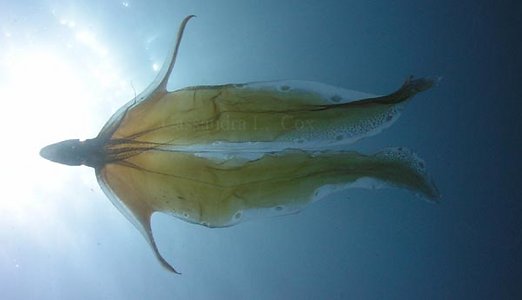


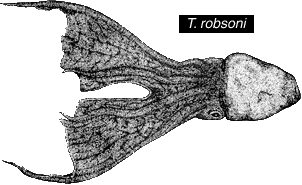




 Go to quick links
Go to quick search
Go to navigation for this section of the ToL site
Go to detailed links for the ToL site
Go to quick links
Go to quick search
Go to navigation for this section of the ToL site
Go to detailed links for the ToL site